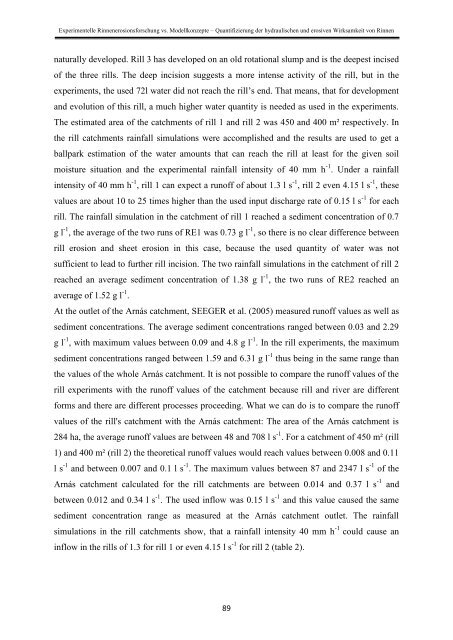Stefan Wirtz Vom Fachbereich VI (Geographie/Geowissenschaften ...
Stefan Wirtz Vom Fachbereich VI (Geographie/Geowissenschaften ...
Stefan Wirtz Vom Fachbereich VI (Geographie/Geowissenschaften ...
You also want an ePaper? Increase the reach of your titles
YUMPU automatically turns print PDFs into web optimized ePapers that Google loves.
Experimentelle Rinnenerosionsforschung vs. Modellkonzepte – Quantifizierung der hydraulischen und erosiven Wirksamkeit von Rinnen<br />
naturally developed. Rill 3 has developed on an old rotational slump and is the deepest incised<br />
of the three rills. The deep incision suggests a more intense activity of the rill, but in the<br />
experiments, the used 72l water did not reach the rill’s end. That means, that for development<br />
and evolution of this rill, a much higher water quantity is needed as used in the experiments.<br />
The estimated area of the catchments of rill 1 and rill 2 was 450 and 400 m² respectively. In<br />
the rill catchments rainfall simulations were accomplished and the results are used to get a<br />
ballpark estimation of the water amounts that can reach the rill at least for the given soil<br />
moisture situation and the experimental rainfall intensity of 40 mm h -1 . Under a rainfall<br />
intensity of 40 mm h -1 , rill 1 can expect a runoff of about 1.3 l s -1 , rill 2 even 4.15 l s -1 , these<br />
values are about 10 to 25 times higher than the used input discharge rate of 0.15 l s -1 for each<br />
rill. The rainfall simulation in the catchment of rill 1 reached a sediment concentration of 0.7<br />
g l -1 , the average of the two runs of RE1 was 0.73 g l -1 , so there is no clear difference between<br />
rill erosion and sheet erosion in this case, because the used quantity of water was not<br />
sufficient to lead to further rill incision. The two rainfall simulations in the catchment of rill 2<br />
reached an average sediment concentration of 1.38 g l -1 , the two runs of RE2 reached an<br />
average of 1.52 g l -1 .<br />
At the outlet of the Arnás catchment, SEEGER et al. (2005) measured runoff values as well as<br />
sediment concentrations. The average sediment concentrations ranged between 0.03 and 2.29<br />
g l -1 , with maximum values between 0.09 and 4.8 g l -1 . In the rill experiments, the maximum<br />
sediment concentrations ranged between 1.59 and 6.31 g l -1 thus being in the same range than<br />
the values of the whole Arnás catchment. It is not possible to compare the runoff values of the<br />
rill experiments with the runoff values of the catchment because rill and river are different<br />
forms and there are different processes proceeding. What we can do is to compare the runoff<br />
values of the rill's catchment with the Arnás catchment: The area of the Arnás catchment is<br />
284 ha, the average runoff values are between 48 and 708 l s -1 . For a catchment of 450 m² (rill<br />
1) and 400 m² (rill 2) the theoretical runoff values would reach values between 0.008 and 0.11<br />
l s -1 and between 0.007 and 0.1 l s -1 . The maximum values between 87 and 2347 l s -1 of the<br />
Arnás catchment calculated for the rill catchments are between 0.014 and 0.37 l s -1 and<br />
between 0.012 and 0.34 l s -1 . The used inflow was 0.15 l s -1 and this value caused the same<br />
sediment concentration range as measured at the Arnás catchment outlet. The rainfall<br />
simulations in the rill catchments show, that a rainfall intensity 40 mm h -1 could cause an<br />
inflow in the rills of 1.3 for rill 1 or even 4.15 l s -1 for rill 2 (table 2).<br />
89
















